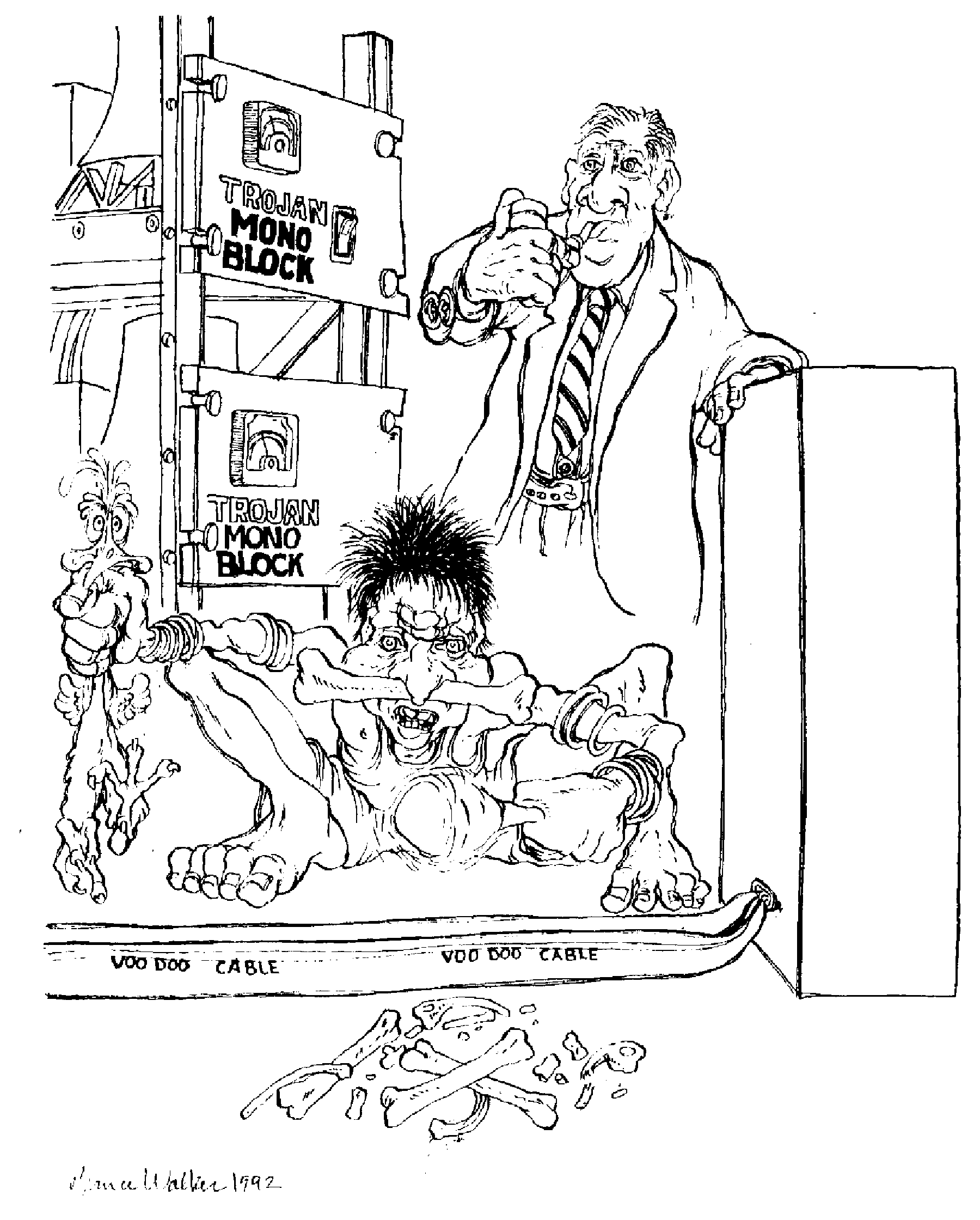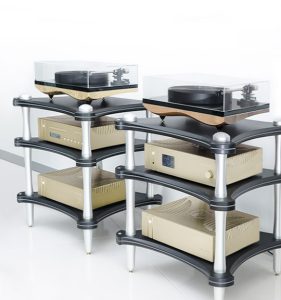WARNING: This may very well be the most controversial article on High-End audio you'll ever read.
Roger Skoff at the LAOC Audio Society Gala, 2018
Are you going to put together a new High-End audio system? Start with the cables! Read on to find out why this can give you better sound and save you thousands of dollars, now and in the future.
My name is Roger Skoff. I am a cable designer, and, after selling my former company, XLO, some years ago, I have a new company (named RSX Technologies) that I am in the process of founding, and our products are already being referred to as "The New Best in the World." Before you immediately leap to conclusions though, and assume that what follows must just be an attempt to sell you something, let me tell you that, at least initially, RSX will have only a very limited line of products, NOT including either interconnects or speaker cables—the cables a person building a new system would most likely to need to buy.
I don't have a dog in this particular fight, but I do have inside knowledge that you can benefit from, so keep on reading.
The first thing to know about any system is that, of all of the components going into it, the two least likely to have been designed by an expert are the speakers and the cables: Anyone at all, with any level of knowledge at all, can take any driver at all or any combination of drivers; put them into any box, or no box at all, with any crossover or no crossover at all; wire it together and hook it up to an amplifier and a signal source, and it will produce sound, and he will be able to declare himself a speaker designer.
Similarly, any person at all can take any two conductors—a 30 gauge Kynar insulated "hookup" wire, for example, and one of the support cables from the Golden Gate Bridge (or a bobby pin and a railroad track)—and arrange them to complete a circuit between one electronic component and another, and they will pass signal, and the person doing it can claim to be a cable designer.
So how does that matter? Well, consider this: no one can start hanging transistors, tubes, capacitors, resistors, switches, inductors, and various other electronic components together at random (probably not even that "infinite number of monkeys over an infinite period of time") and have it turn into a usable amplifier, preamp, CD player, or other High-End audio device. In order to get any such thing to function at all, a person needs to have better than just a "pretty good" idea of what he's doing or it simply won't work!
That's why the difference between the very best possible electronic device and the very worst one that functions may be less than the difference between the very best and worst speakers or cables. And with speakers, the problem is compounded (making your choice of speakers to buy even harder) by the fact that the room that it's playing in can have an immense effect on the sound of a speaker, with the exact same speakers sounding completely different in different listening rooms or even in different parts of the same room. (Ask Norman Varney about this. He's an expert on such things.)
So why start with cables? And do cables really make any difference at all?
Let's take the second question first: Yes, they do! Even though there's on-going controversy about it on nearly every one of the Hi-Fi sites on the social media (and in the print media, as well), the fact of it is that, despite many of the engineers or engineers-manqué among us declaring that cables don't affect a system's sound, and saying that the only things about them that matter are resistance (R), capacitance (C), and inductance (L), the truth is that cables are—from a physics and field-theory standpoint—wildly complex, and it's fiendishly difficult (and expensive) to get them to not have any effect on the signals they carry.
That's why cables are so difficult to properly design; why they're so important to the sound of your system; and why, in putting together a new system, cables are the place to start. (If, incidentally, you're interested, you can see why engineers are so often wrong about wire by reading my article "HERE" in The Absolute Sound, March, 2015.)
Unlike any other component of an audio system, cables' only job is to carry the signal from one place (a preamp, for example) to another (an amplifier). In doing so, anything at all that they do to it, other than to simply pass it along, is problematic: If there are signal losses, that's bad—they're not letting you hear all of the exquisite detail that's on the recording and that you have paid so much to buy great components to reveal for you. If they add anything (like hum, noise, or capacitive discharge artifacts from poorly designed or selected dielectrics—the cable's insulation) they're also keeping you from enjoying your music to its full extent and, again, keeping you from hearing all and only the performance of the other gear that you've spent (or will spend) so much to buy. Similarly, any change at all to the signal—from its source (the phono cartridge, CD player, tuner, streaming device, or whatever else), all the way through to the speakers, is distortion and, if the cables are contributing any part of it, they're not properly doing their job.
What you need cables to be is "neutral"—to neither add nor subtract anything from the signal they carry, and to not change it in any way in the process. And, if you can find some that are (or that you can afford, and that even come close) buy them; they're the perfect first purchase for your system.
The reason for this is that no matter which part of any system you're auditioning, you're not just listening to that one thing: You can't hear a speaker without cables, an amplifier or receiver, and a source component. Neither can you listen to any other part without all of the others. That's why a system is called a system: It's an agglomeration of parts, all of which are necessary to play the music and create the sound you want to hear. And all of it must eventually go through cables at one or more points along the way.
That's why cable neutrality is important, and why the critics may be absolutely wrong when they describe a cable as "system dependent." What they mean by that is that usually a cable will seem to change the sound of the system it's plugged into, and that it will sound different on different systems. That's not bad; that's good! Just as, if you pour chocolate syrup all over everything you eat, everything will taste of chocolate, so will a cable that's "colored" (has a distinct sound of its own) make every system it's used in sound the same. What you want is not that, but the cables that, when you try them on a dozen different systems, the systems have a dozen different "sounds."
And that's exactly how you can find out which cables are the most neutral: Get hold of a bunch of different cables, and try each one out on as many different systems as you can. The cable that sounds the most different on the greatest number of systems is the one that's the most neutral and is the one that you should buy.
Once you've got your cables, you can then go into your dealer's demonstration room and, using them, listen to all of the other components that you need, knowing that you're hearing those components, to the greatest degree possible, exactly as they really sound.
Beware, though, if the dealer has set his demo system up with a "dark" sounding "Thing A" and a neutral sounding "Thing B," connected by a "bright" sounding cable, (or any other mix of components where the flaws of one thing are used to cancel out the flaws of another). Adding a neutral sounding cable to a system like that will actually make the system sound worse when you put in the more neutral sounding cable. That's one reason, just in itself, why you should always try cables on as many systems as possible.
If you do that, and if you actually do find neutral sounding cables, and buy them and use them as the basis for your own system, you'll not only have a better sounding system, that gives you a more accurate presentation of the glories of the music, the sound of your other components, and the interaction of them with your listening room but, when you later buy other components or speakers to upgrade your original system, you won't have to spend more money on cables. The ones you've got will already be neutral and, except to buy some that might be even more neutral, you won't have to buy any cables at all. You can either keep your cable money in your pocket or spend it on better other components or on improving the acoustics of your listening room.
Start with the cables; it makes good sense and it makes good sound!
Photograph and image processing by David W. Robinson; drawing by Bruce Walker.








































